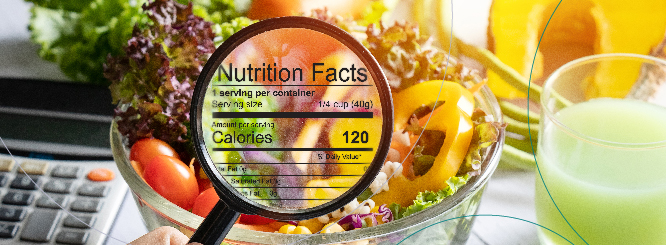
Obesity is a chronic disease that involves many factors, including health, economics, and lifestyle. Being overweight or obese are similar conditions that might affect everyone in society, no matter gender, race, role, or age. However, certain populations, including children and young adults, are more vulnerable to suffering from these conditions. In North America and all over the world today, we see increased levels of obesity that are higher than in previous years.
This makes us question and analyze quite closely the way in which people’s lifestyle has changed and those changes have undoubtedly been more pronounced in the past 30 to 40 years. It also gives us an opportunity to understand the problem better, as well as a better chance to come up with a solution: healthy eating. But what does that mean? Maybe regulated portions, less junk food, and more vegetables and fruits? We’ll discuss it in more detail in this article.
The Role of Food Portion Control
Food portion control refers to the practice of managing the quantity of food[1] you consume in each meal or snack. It involves understanding appropriate serving sizes and adjusting your intake accordingly. Portion sizes in restaurants, coffee shops, movie theaters, and packaged foods have significantly increased over the years, which makes us believe it could be a normal serving, now called “portion distortion”[2] being one of the main contributors to being overweight.
Larger portions often result in overconsumption of calories, fat, and sugar, contributing to weight gain and obesity.
Overeating, even nutritious food, can lead to weight gain and a host of associated health problems. On the other hand, consuming smaller portions can help you maintain a healthy weight, reduce the risk of chronic diseases, and increase energy levels. Learning to recognize and control portion sizes is vital for maintaining a balanced diet plus a healthy lifestyle.
Daily Serving Size and Portions in Today’s World
As we mentioned above, in today’s fast-paced world, where oversized portions and super-sized meals have become the norm, maintaining a healthy diet can be challenging. Thus, portion control plays a crucial role in achieving and maintaining a healthy weight, as well as promoting overall well-being. Worldwide obesity has nearly tripled since 1975 and portions have changed drastically; a clear example is the massive size of soft drinks, French fries, and foods like hamburgers, we can easily find today.
The serving size on a food label may be more than or less than the amount you should eat[3]. That’s because how many calories you need each day to maintain your weight or lose weight may depend on:
- Your age
- Your current weight and height
- Your metabolism
- Whether you’re male or female
- How active you are
However, you can start a balanced diet with proper recommendations or the right meal plan for you (you can ask your nutritionist or your doctor). For example, here we list some recommendations that every person should include and reduce in their daily diet according to the Dietary Guidelines for Americans 2020–2025[4].
- Mostly fruits, vegetables, whole grains, and fat-free or low-fat milk and milk products.
- A variety of protein foods such as seafood, lean meats and poultry, eggs, legumes (beans and peas), soy products, nuts, and seeds.
- Low added sugars, sodium, saturated fats, trans fats, and cholesterol.
- Take into consideration your daily calorie needs according to your age, gender, weight, and height.
It’s important to note that these guidelines may not be suitable for everyone, so the right portion or meal size should always be personalized. It is always a good idea to consult with a healthcare professional or registered dietitian to get personalized advice based on your specific needs and health conditions.
The Plate of Good Eating
The plate of good eating is a visual representation of a balanced and healthy meal, often used to guide individuals in making nutritious food choices. While there are different variations of the plate depending on cultural and dietary preferences, one widely recognized example is the MyPlate model, developed by the U.S. Department of Agriculture (USDA)[5]. Here’s a minimal example of the plate model:
- Fill half your plate with fruits and vegetables
- Make a quarter of your plate whole grains
- Include a quarter of your plate with lean proteins
- Add a serving of dairy or alternatives
- Include a small amount of healthy fats
Remember that the plate of good eating is a general insight, and individual dietary needs may vary. It’s essential to consider factors such as personal health goals, allergies, and cultural preferences when planning your meals. Consulting with a registered dietitian can provide personalized recommendations based on your specific needs.
Some Food Portion Guidelines
- Try to read food labels, pay attention to serving sizes mentioned on food labels, and adjust your portions accordingly. Be mindful of the number of servings in a container to avoid unintentionally consuming more than recommended.
- Use smaller plates and bowls, and downsize your dishware to create an optical illusion of a fuller plate. Using smaller plates and bowls can help control portion sizes and reduce the tendency to overeat.
- Practice mindful eating, slow down, and savor each bite of your food. Focus on the flavors, textures, and aromas of your food, promoting a more satisfying eating experience. Eating mindfully allows you to tune into your body’s hunger preventing you from overeating.
- Portion pre-plate, so instead of serving family-style at the table, plate your meals in the kitchen. This strategy prevents mindless second servings and encourages portion awareness.
- Fill half your plate with vegetables because they are low in calories and high in nutrients. By filling half your plate with colorful vegetables, you automatically reduce the space available for larger portions of calorie-dense foods[6].
- Be conscious of liquid beverages like sodas, juices, and alcoholic drinks, which can contribute to excessive calorie intake. Opt for water, unsweetened tea, or other low-calorie alternatives to fulfill your thirst without adding extra calories.
- Creating a meal-prep routine, planning and preparing meals ahead of time can help you make healthier choices and control portion sizes. Create a balanced meal plan and use portioned containers to pack your meals for the day.
- Share your goals with a friend, or family member, or join a community that focuses on healthy eating. Having support and accountability can keep you motivated and help you stay on track.
Food portion control is a powerful tool for achieving and maintaining a healthy lifestyle. By understanding the significance of portion sizes and adopting practical strategies to control them, you can make positive changes in your diet. Remember, healthy eating is not about deprivation but rather about balance and mindful choices.
By paying attention to portion sizes and making conscious decisions, you can enjoy a wide variety of foods while nourishing your body and achieving your health goals. Start small, stay consistent, and watch how portion control can change your life positively.
At LIMARP® one of the main life lessons our patients learn is portion control. The commitment they make when they decide to have bariatric surgery allows them to have almost automatic control of their portions, but we do not leave it at that. We also offer a clear pre and post-op eating plan, vitamin supplementation specially designed for the bariatric patient, and counseling on how to tell real portions from the “inflated” portions of today’s market.
Contact Us to Learn More
If you want to learn more about food portions, schedule an appointment with one of our doctors. We can help determine the right treatment for you. Contact us online anytime or give us a call at (619) 373-0229.
References:
[1, 3] “Food Portions: Choosing Just Enough for You”. https://www.niddk.nih.gov/health-information/weight-management/just-enough-food-portions. (Accessed May 25, 2023).
[2] “Serving Sizes and Portions”. https://www.nhlbi.nih.gov/health/educational/wecan/eat-right/distortion.htm. (Accessed May 25, 2023).
[4] “Dietary Guidelines for Americans, 2020-2025”. https://www.dietaryguidelines.gov/sites/default/files/2020-12/Dietary_Guidelines_for_Americans_2020-2025.pdf#page=31. (Accessed May 25, 2023).
[5] “What is MyPlate?”. https://www.myplate.gov/eat-healthy/what-is-myplate. (Accessed May 25, 2023).
[6] “Healthy Eating for a Healthy Weight”. https://www.cdc.gov/healthyweight/healthy_eating/index.html#:~:text=Emphasizes%20fruits%2C%20vegetables%2C%20whole%20grains,%2C%20trans%20fats%2C%20and%20cholesterol. (Accessed May 25, 2023).


